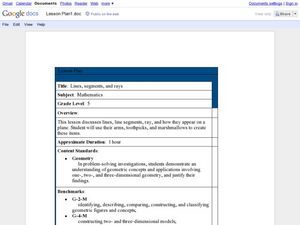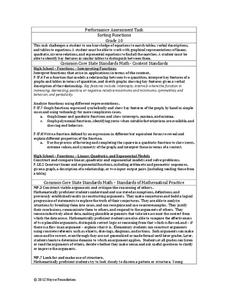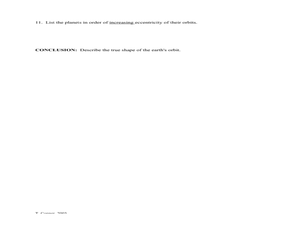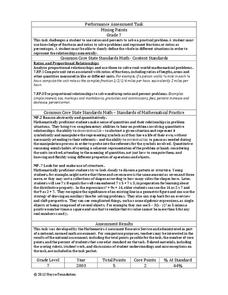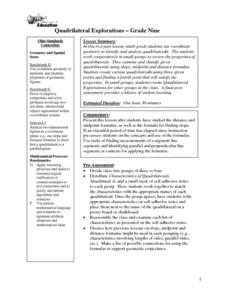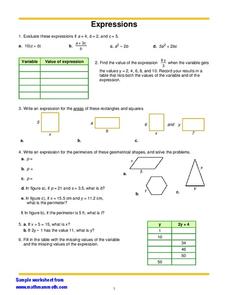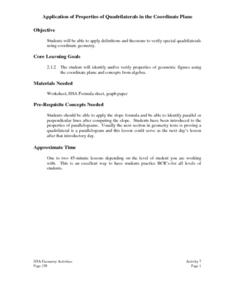Curated OER
Distortion Unleashed
Students view examples of man-made structures and create a building that matches the style. Using the internet, they research the style of Frank Lloyd Wright and create plans for creating their own community. They use a painting of...
Curated OER
Artistic Angles
Fifth graders explore angles by using protractors. They recognize, describe and determine the surface area and volume of three-dimensional shapes. Students recognize the right angle, acute angle, obtuse angle and vertex. They identify...
Pennsylvania Department of Education
Creating Polygons
Students describe, make and compare polygons. For this creating polygons lesson, students identify properties of quadrilaterals and describe common features of two dimensional shapes.
Curated OER
Who Am I? (Middle School)
Third graders complete a classroom game used to build understanding of two and three-dimensional shapes. Diagonals, sides, regularity, congruency, angle measurements, parallels, perpendicular, faces, and edges are a few of the vocabulary...
Curated OER
Lines, Segments, and Rays
Fifth graders use their arm, toothpicks, and marshmallows to create lines, segments, and rays. In this lines, segments, and rays lesson plan, 5th graders learn how these appear on a plane.
Curated OER
Review Geometry Week
Fifth graders participate in a review game of geometry topics. For this geometry lesson, 5th graders use the "Eggspert" interactive classroom game system to review the geometry skills taught that week. Students work in teams to complete...
Curated OER
Do You Feel Lucky?
Students explore probability by using games based on probable outcomes of events. They name all of the possible outcomes of an event and express the likelihood of such an event occurring.
Inside Mathematics
Sorting Functions
Graph A goes with equation C, but table B. The short assessment task requires class members to match graphs with their corresponding tables, equations, and verbalized rules. Pupils then provide explanations on the process they used to...
Curated OER
Ellipse Lab
Leading the students to draw a representation of ellipses of planets, this handout will help understanding the planet movement around the sun. There are ten questions about the analysis of those orbits and a conclusino specifically...
Curated OER
Inquiry Unit: Modeling Maximums and Minimums
Young mathematicians explore the maximun area for patio with the added complexity of finding the mimimum cost for construction. First, they maximize the area of a yard given a limited amount of fence and plot width v. area on a...
Inside Mathematics
Snakes
Get a line on the snakes. The assessment task requires the class to determine the species of unknown snakes based upon collected data. Individuals analyze two scatter plots and determine the most likely species for five...
Noyce Foundation
Mixing Paints
Let's paint the town equal parts yellow and violet, or simply brown. Pupils calculate the amount of blue and red paint needed to make six quarts of brown paint. Individuals then explain how they determined the percentage of the brown...
Inside Mathematics
Two Solutions
Many problems in life have more than one possible solution, and the same is true for advanced mathematics. Scholars solve seven problems that all have at least two solutions. Then three higher-level thinking questions challenge them to...
Curated OER
Transformations on the Coordinate Plane
Here is a study guide on transformations that includes reflections, translations, dilations, and rotations. It also has definitions, helpful diagrams, and several examples involving transformations on the coordinate plane. The lesson...
Curated OER
Quadrilaterals
In this geometry worksheet, 10th graders solve problems with quadrilaterals. They calculate the sum of the angles, find missing angles and identify properties of quadrilaterals. There are 16 questions with an answer key.
Curated OER
Pairs of Angles
In this geometry learning exercise, 10th graders determine the measures of various angle pairs: supplementary, complementary, and vertical angles. The two page learning exercise contains a combination of twelve multiple...
Curated OER
Applying Proportionality in Scale Drawings
Sixth graders examine a blue print and discuss the reasoning behind using blue prints. In this proportionality lesson plan, students collaborate with their teammates to create a scale drawing. Once that is complete, 6th graders...
Curated OER
Quadrilateral Explorations
Ninth graders identify quadrilaterals and label the vertices of quadrilaterals. they justify their identification of the quadrilaterals. Students work in groups to identify and create quadrilaterals
Curated OER
Quadrilateral Explorations-Grade Nine
Ninth graders investigate quadrilaterals. In this geometry lesson plan, 9th graders examine and classify quadrilaterals using the slope, midpoint and distance formulas. Additionally, students create various quadrilaterals...
Curated OER
Rectangles and Trapezoids in the Coordinate Plane
Students determine the missing vertices of quadrilaterals. In this rectangles and trapezoids lesson, students examine the characteristics of quadrilaterals. They identify the missing vertices of a quadrilateral on a coordinate plane.
Math Mammoth
Expressions
In this expression worksheet, learners evaluate equations, write equations for a specified event, and determine the perimeter of shapes, Six multi-step problems are provided on this one-page worksheet.
Curated OER
Quadrilaterals in the Coordinate Plane
Students find the coordinates of the vertices of special quadrilaterals placed in the coordinate plane. They find the coordinates of missing vertices of squares and parallelograms.
Curated OER
Teaching and Learning Through Objects
Students identify and interpret the function, usefulness or utitlity, form, beauty or aesthetics, and meaning, context or story, of objects and how they learn new skills and make things that they learn traditionally, by observation and...
Curated OER
Application of Properties of Quadrilaterals in the Coordinate Plane
Learners apply definitions and theorems to verify special quadrilaterals
using coordinate geometry. They apply the slope formula, the midpoint
formula, and the distance formula to justify that a given quadrilateral is a
parallelogram....




